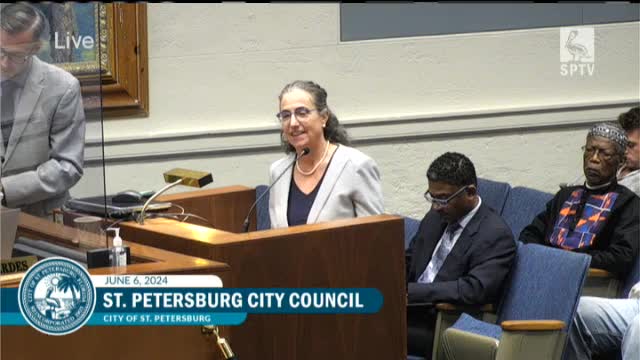City leaders push for bold zoning changes to boost housing
June 06, 2024 | St. Petersburg, Pinellas County, Florida

This article was created by AI summarizing key points discussed. AI makes mistakes, so for full details and context, please refer to the video of the full meeting. Please report any errors so we can fix them. Report an error »

During a recent government meeting, officials discussed significant changes to zoning regulations aimed at fostering development and innovation in St. Petersburg's urban areas. A key topic was the proposed adjustments to the Floor Area Ratio (FAR), with some officials advocating for an increase from the current 1.5 to 2.5. This change is seen as essential for encouraging workforce housing and enabling developers to create more market-rate units, which could help offset the costs associated with affordable housing projects.
One official emphasized the need for a more flexible FAR to reflect the city's current needs, arguing that a higher ratio would facilitate real progress in the district. The proposal includes a workforce housing bonus that could allow developers to reach up to 3.5 FAR, providing additional incentives for creating affordable housing options.
Another significant discussion point was the duration of temporary use permits for entrepreneurial projects, such as food trucks and pop-up markets. Currently set at six months with a possible extension, officials considered extending this period to one year to better support innovation and experimentation in the city's creative districts. The rationale behind this proposal is that many new business concepts require more time to establish themselves and assess their viability.
City officials acknowledged the importance of balancing flexibility for entrepreneurs with the need to monitor any potential negative impacts on the surrounding community. The zoning official noted that while the six-month period has not hindered temporary uses, extending it could provide more opportunities for creative ventures to thrive.
Overall, the meeting highlighted a proactive approach to urban development, with officials committed to modernizing zoning laws to better serve the community's evolving needs. Further discussions and potential adjustments to these proposals are expected in upcoming committee meetings.
One official emphasized the need for a more flexible FAR to reflect the city's current needs, arguing that a higher ratio would facilitate real progress in the district. The proposal includes a workforce housing bonus that could allow developers to reach up to 3.5 FAR, providing additional incentives for creating affordable housing options.
Another significant discussion point was the duration of temporary use permits for entrepreneurial projects, such as food trucks and pop-up markets. Currently set at six months with a possible extension, officials considered extending this period to one year to better support innovation and experimentation in the city's creative districts. The rationale behind this proposal is that many new business concepts require more time to establish themselves and assess their viability.
City officials acknowledged the importance of balancing flexibility for entrepreneurs with the need to monitor any potential negative impacts on the surrounding community. The zoning official noted that while the six-month period has not hindered temporary uses, extending it could provide more opportunities for creative ventures to thrive.
Overall, the meeting highlighted a proactive approach to urban development, with officials committed to modernizing zoning laws to better serve the community's evolving needs. Further discussions and potential adjustments to these proposals are expected in upcoming committee meetings.
View full meeting
This article is based on a recent meeting—watch the full video and explore the complete transcript for deeper insights into the discussion.
View full meeting